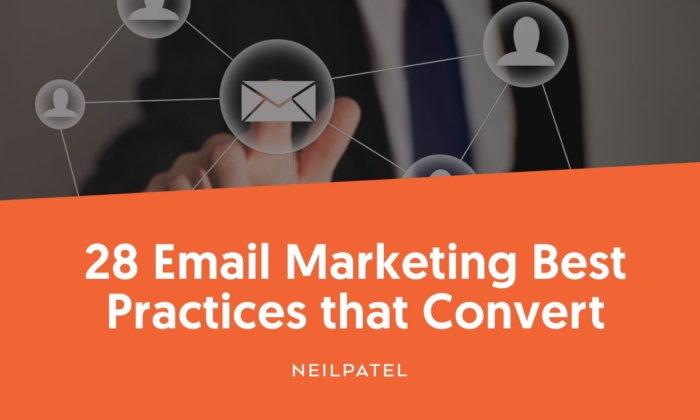
Did you know that email is still one of the most effective ways to communicate with your customers? It’s true! In fact, 4 out of 5 marketers say they’d rather give up social media than email marketing.
But some business owners don’t use email marketing best practices, decreasing their chances of success.
That’s what I’m discussing today.
In this blog post, we discuss 28 email marketing best practices..
I’ll talk you through segmenting email campaigns, personalizing subject lines, setting goals, and a whole lot more:
Like:
- Optimizing Your Preview Text
- Offering Something Valuable
- Making Unsubscribing Easy
- Tracking and Optimizing
Ready to join me? Let’s go!
Key Takeaways
- Email marketing is still one of the most effective ways to communicate with your customers.
- Implementing best practices like segmentation, personalization, and A/B testing can increase open and click-through rates.
- Deliver relevant content and build drip campaigns to improve customer relationships.
- Paying attention to deliverability, using a responsive design, and avoiding spam filters are important for email success.
- Monitor and adapt industry trends to help your businesses stay ahead of the competition.
1. Segment Your Email Campaigns
Segmentation is one of the top email marketing best practices. Want to know why? By segmenting your email list and tailoring your content to subscribers’ specific needs, you increase email relevancy and improve open and click-through rates.
Campaign segmentation involves dividing your email list into groups or segments based on shared characteristics, such as gender, age group, location, or purchase history. This allows you to send tailored content to each group, boosting engagement and conversions.
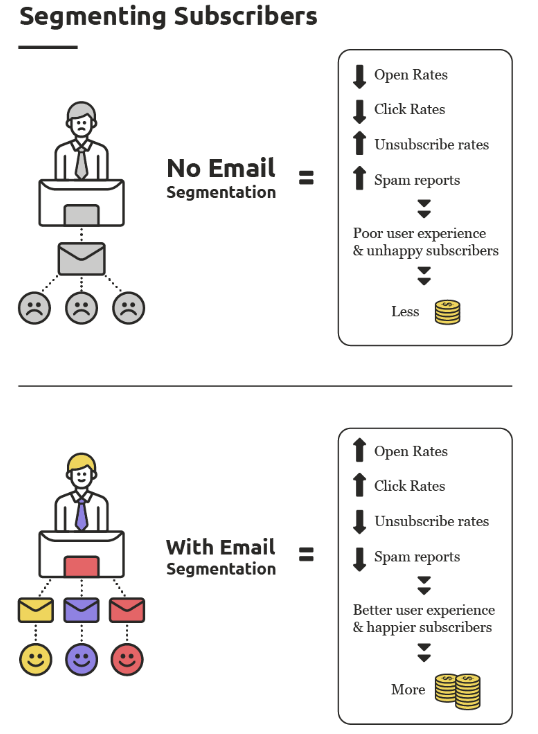
Here’s how to segment your email list:
- Think about the problems your subscribers are trying to solve and the information they need to make a purchase decision.
- Decide how you want to segment your list.
- Use a tool like Mailchimp or Constant Contact to set up groups within your email list.
- Create relevant email content for each group.
2. Personalize Your Content
Why personalize? Seventy-two percent of consumers say they only engage with content tailored to them.
When you personalize your email content, you connect with your contacts on a human level, and personalization is a cinch. Just include a personalization token like “Dear [First Name].”.
You can also use personalization tokens to customize the email content. For example, you could include a sentence like, “If you’re looking for [Topic], you’ll love what we have in store for you this week.”
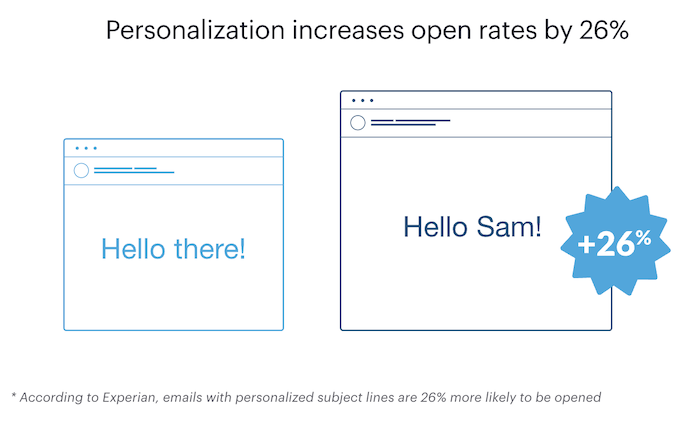
3. Optimize Your Preview Text
The best way to ensure your customer opens your email is to optimize the subject and preview text.
Research from Mailjet found that 24 percent of subscribers check out the preview text (that little bit of text that shows up with your subject line) before deciding whether to open an email.

If you don’t include it, most email clients will pull the first few lines of your body copy as preview text. This can often result in low-quality or irrelevant preview text that doesn’t accurately reflect the email’s content. And if the first line of your email says, “Email not displaying correctly,” you’ll have difficulty convincing someone to open it.
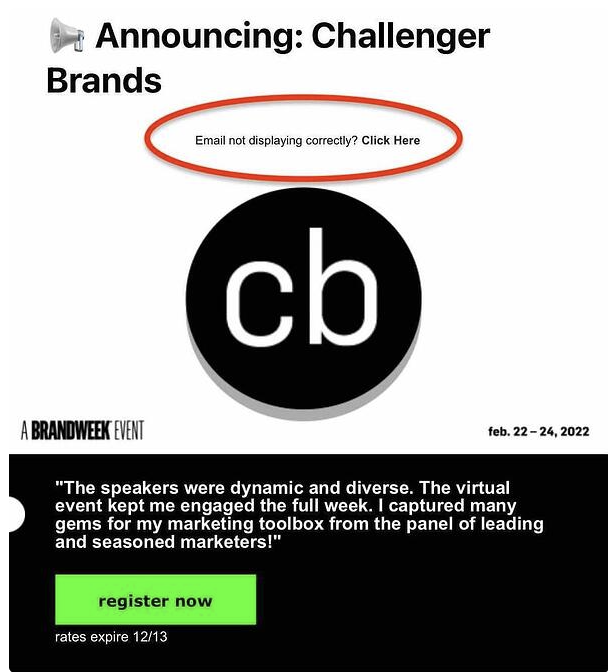
Generally, the email marketing best practice for preview text is to keep it between 40 and 130 characters long.
Here are a few other email marketing best practices to consider for your email subject lines and preview text:
- Think about what’s most important to your reader and provide value.
- Make your subject line and preview text work together.
- Use your preview text to entice your user to open the email.
- Keep it concise, and include a call to action.
- Test text on mobile and desktop email clients
4. Offer Something Valuable
Your email marketing should always focus on your subscribers’ interests and offer value or exclusive discounts. Here’s an example from NARS Cosmetics:
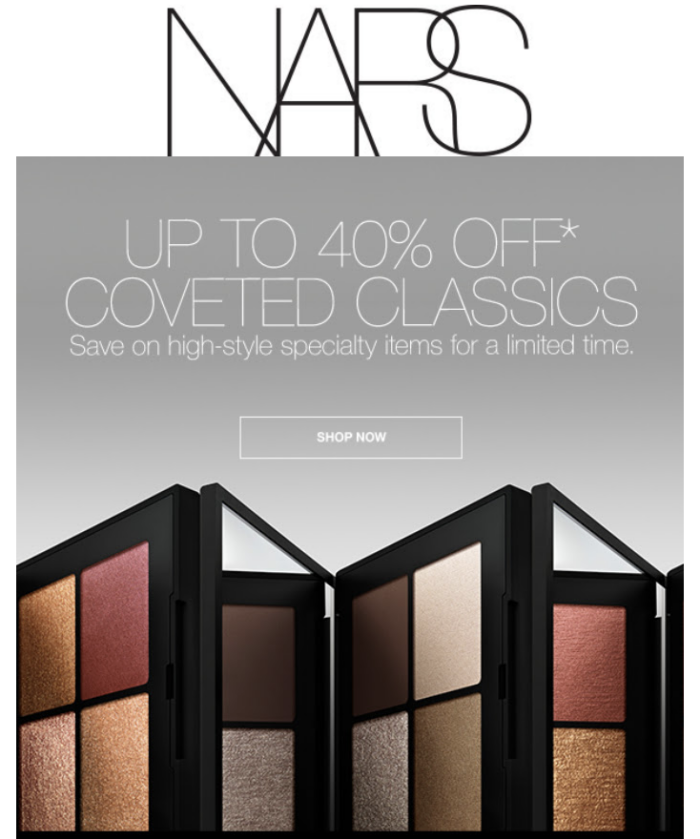
Remember, examples of valuable information will change depending on your industry.
Not every brand sells a product—some may offer educational information or updates on new projects. Whichever type of audience you’re selling to, ensure you understand their pain points and what content helps to solve them. Then, you can create email content that’s laser-focused on providing value.
5. Make Unsubscribing Easy
While your main goal in email marketing might be to grow your list, you’ll lose some subscribers along the way.
That’s okay! According to MailerLite, unsubscribe rates across industries are around 0.24 percent.
And you don’t want uninterested subscribers because they can lead to:
- lower open rates
- emails reported as spam
- bad deliverability
- lower returns
If a subscriber wants to leave, it doesn’t matter. After all, our priorities and interests change all the time. Just ensure you make unsubscribing painless as this will keep you compliant with Google.
According to Google’s new email sender guidelines, customers should be able to unsubscribe with one click from February 2024. The unsubscribe link should also be visible in the email footer. If you’re using a hyperlink, ensure the link is big enough for people using mobile devices to click on it easily.
6. Decide on Frequency and Goals
The first step in creating a high-performing email marketing campaign is to decide on your goals and frequency.
Are you emailing weekly? Monthly? Quarterly? Find a happy medium that works for both you and your subscribers.
And what are you emailing about? New products? Sales? Tips and advice?
Your email campaign goals determine the content you’re sending, and how often you send it.
For example, a B2B business may see its audience tune out when they touch base too often.
Many B2B businesses that follow email marketing best practices find they get more engagement and click-throughs from subscribers when they send emails monthly or quarterly.
The key is to experiment and see what works best for you and your business.
7. Build a Schedule
According to Smart Insights, 47 percent of organizations don’t have a defined marketing strategy. The answer? Use an editorial calendar to plan your email content.
Your email marketing content calendar should include:
- The dates you plan to send your email campaigns
- A list of email marketing topics
- Any other content that needs to be included in your emails ( images, videos, etc.)
Here’s an example of a simple email marketing campaign content calendar from Moosend; the platform also offers free downloadable templates.
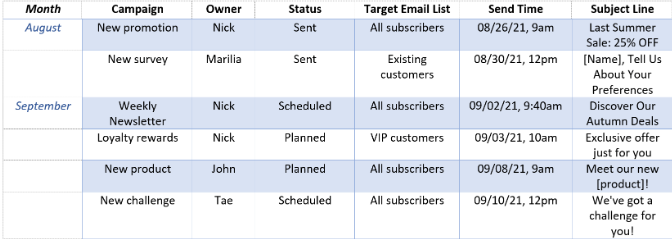
Additionally, leave some wiggle room in your email marketing strategy to adapt to trends and industry updates. It’s always good to be flexible!
8. Create Separate Emails for Each Goal
Now that you know when you’ll send your email campaigns, it’s time to start looking at the content. But where do you start?
One of the top email marketing best practices when creating email marketing content is always keep your goals in mind, for example:
- Are you trying to increase brand awareness?
- Would you like to drive traffic to your website?
- Is it time to make a sale?
Creating separate emails for each goal helps you create more targeted campaigns and ensure your list gets the most relevant information.
Let’s say your goal is driving more traffic to your website. In that case, your emails should include links to recent blogs, lead magnets, and latest products/services.
9. Email A/B Testing: Timing
One of the most important email campaign best practices is to A/B test different times, such as different days of the week and times of day, to see when you get the most engagement.
Here’s an example of the best days to send emails from Moosend.
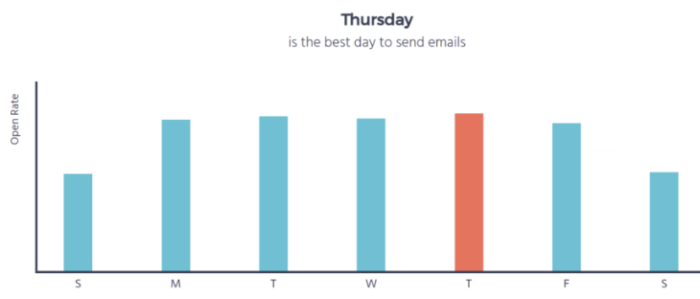
Note: Don’t forget your email list may have different preferences depending on their location. For example, if you have many subscribers in India, you’ll want to pay attention to the time difference and send your emails when it’s best for them.
To start with A/B testing:
- Create two versions of your email campaign with different subject lines, content, or email timing.
- Use an email marketing tool like Mailchimp to send both versions to a small group of subscribers and track which one performs better.
- Once you have the results, go with them.
By testing different email options and strategies, you can fine-tune your email marketing to meet your subscribers’ needs better and make your messaging timely, relevant, and engaging.
10. Track and Optimize
Email marketing best practices need ongoing tracking and optimization if you want your marketing to succeed. That’s where email marketing platforms come in.
For example, Mailchimp’s analytics dashboard shows you things like:
- How many people opened your email
- What links they click
- Whether they forwarded the email
Periodically review your email analytics and adjust them to improve future results; making changes based on what you learn from your analytics helps improve your email marketing campaigns and ROI.
For example, if you’re noticing a low open rate, you may want to experiment with different subject lines or send times.
11. Deliver Relevant Content
One of the biggest mistakes marketers make is emailing their list with generic content.
For instance, while blasting out discount offers and sale promotions might work for B2C brands, B2B audiences want content to help them do their jobs better.
Your email should always have a point, and that should come across in the email, preview text, and even the subject line.
Airbnb, for instance, knows exactly who it’s talking to.
Everyone knows Airbnb. It’s basically selling unique accommodations to people who love to travel, right?
This is one of the first emails Airbnb subscribers see:
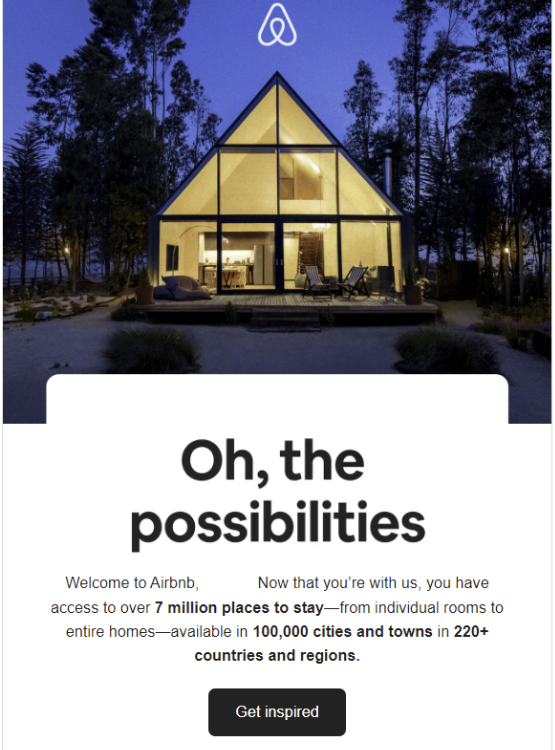
It sounds enticing, doesn’t it?
It tells you about the:
- Seven million places to stay
- 100,000 cities and towns
- 220+ countries and regions
The email then finishes with a “Get Inspired” CTA, that’s sure to get click-throughs from its ideal audience. That’s perfect for the eager traveler who likes holidays with a difference.
You can learn plenty from Airbnb’s approach, but if you’re unsure which content your audience would love the most, try conducting a market research survey.
12. Build Drip Campaigns
Drip campaigns (a series of email messages sent over time) are a great way to nurture leads and move prospects through your sales funnel.
A drip campaign goes something like this:
- The first email is typically a friendly introduction to your company.
- The second email might dive into more information about your product.
- And the third could hook people with a free trial or e-book link.
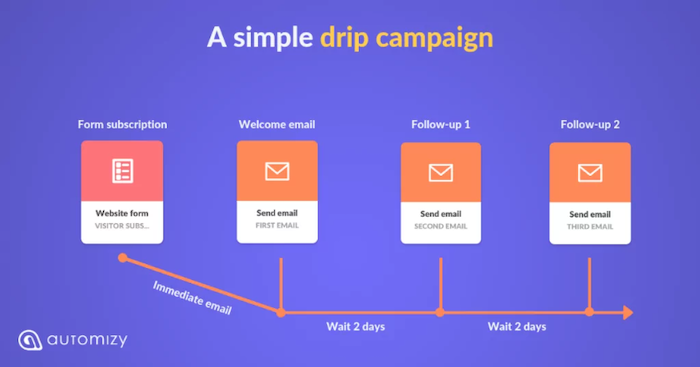
You can create drip campaigns through email automation. If you’re using a mail provider like Mailchimp, Klaviyo, or Active Campaign, you can set up automated email drip campaigns within the platform.
When crafting an email drip campaign, follow these email marketing best practices:
- Segment your audience into lists of active customers, prospects, and past customers.
- Create a welcome email for new subscribers.
- Set up email automation rules to send additional emails based on subscriber engagement.
- For each email in the drip campaign, create custom content for audience segments.
- Make sure each email has a clear CTA.
- Monitor email analytics to see which drip campaigns are most successful.
13. Segment Audiences by Interest Level
Did you know that 78 percent of U.S. internet users say they are more likely to purchase from brands that offer personalized content?
This means segmenting email lists into different groups to send targeted messages to specific subscribers.
For example, if a customer isn’t opening your usual marketing emails, you can tag them as uninterested. Then, you can send them a different email than someone who frequently interacts with your content.
Don’t know where to find audience engagement analytics?
Most email marketing automation platforms have a tagging system. For example, Mailchimp’s groups and segments feature allows you to tag customers according to interests, purchase history, and other data points.
14. Pay Attention to Deliverability
16.9 percent of B2B marketing emails never reach an inbox.
One way to improve your email deliverability is to ensure you only collect email addresses from people who have “opted in.”
This ensures your email list is full of people who want to receive your messages, which can improve your chances of reaching their inbox.
Choose an email service provider that has a good reputation for email deliverability, like Mailchimp, Constant Contact, and AWeber, too.
Finally, look at the time of day that you’re sending your emails.
OptinMonster’s analysis found that Saturdays and Sundays aren’t the best days for sending B2B emails. But this can vary depending on your industry and readers, highlighting why it’s crucial you know your audience inside and out.
15. Include a Clear CTA
B2B best practices for email marketing dictate that emails should always include a clear call to action (CTA). CTAs are the gentle nudges that tell subscribers what you want them to do next and help guide them through the sales funnel.
For example, if you’re shooting an email to a B2B customer about a new product, your CTA could be something like “Learn More,” “Buy Now, or “Download Now.” Just keep it simple and to the point.
Here’s an example of a clear call to action from Google Workspace.
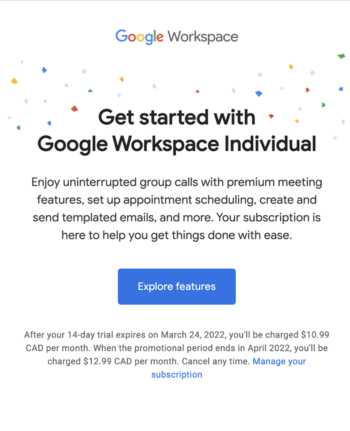
Additionally, you might want to A/B test CTAs to figure out the best words, where to put them, and how they look in your emails.
Email marketing providers like Campaign Monitor offer in-platform A/B testing tools you can leverage to assist with this.
16. Pay Attention to Your Layout
Plenty of folk read or scan emails while they’re on the move, so design your content with that in mind.
Here are some email marketing best practices for writing emails that subscribers can read on the go:
- Include plenty of white space for better readability.
- Keep it snappy with short paragraphs, headlines, and bulleted lists
- Reduce image sizes
- Use a 14-16 px font for body text
Here’s an example from immersive experience company Meow Wolf‘s welcome email.
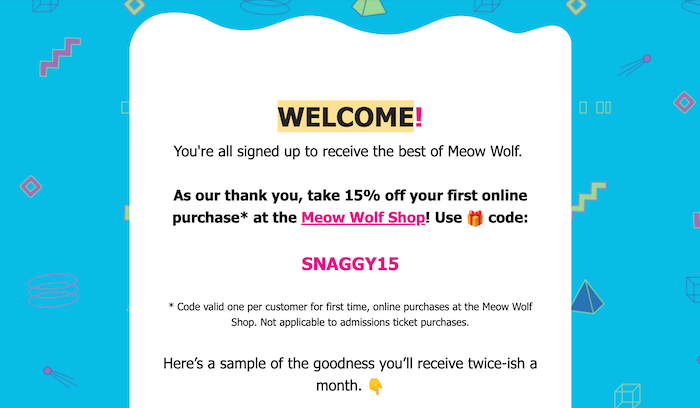
Worried your email design isn’t up to par? It might be time for an email marketing makeover.
17. Don’t Overuse Fonts
One of the biggest design no-nos is going overboard with too many fonts. This can make your email cluttered, which won’t look so good in your customer’s inbox.
Here’s an example of this from FreshMail.
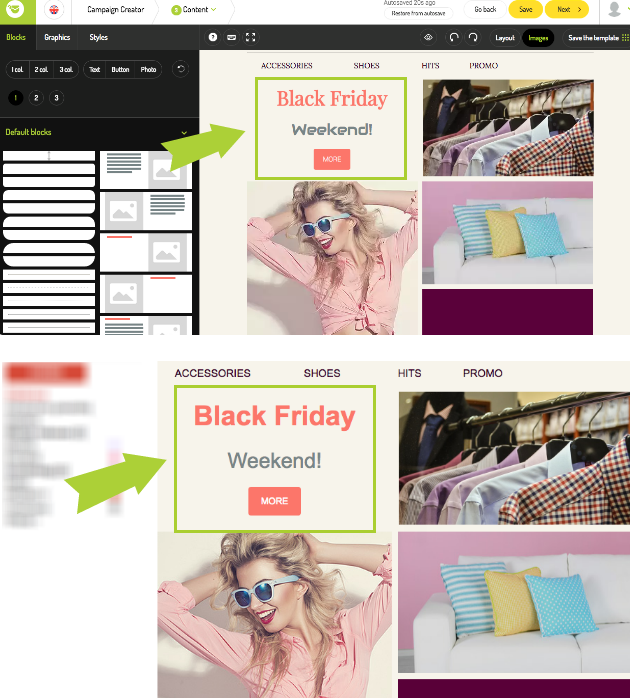
The solution? Stick to one or two fonts throughout your email and use non-serifed fonts like Arial, Verdana, Tahoma, and Trebuchet MS.
If you have specific fonts picked out in your brand guide, feel free to use them. Just always send a test email first to ensure they work well in the email client.
18. Use a Responsive Design
Using responsive design is one of our best practices for email marketing for a reason.
Today, 58 percent of global traffic comes from mobile devices, and consumers read between 50 and 60 percent of emails on a mobile device.
A responsive design automatically changes format to match the size of the screen, whether it’s a desktop computer, a laptop, or a smartphone.
If you’re not sure whether your email design is mobile-friendly, send yourself a test email and view it on your phone. If it’s difficult to read or if the images don’t appear, then you need to make some changes.
Here’s an example from Campaign Monitor. Take a look at the image on the right. That’s how a responsive email looks. See the change?
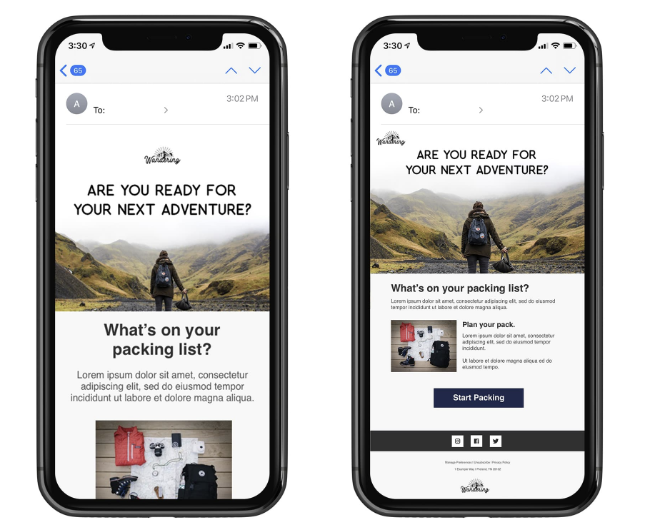
Don’t overlook the tech side of responsive emails, either.
19. Create a Custom Email Signature
Another email campaign best practice tip is creating a custom email signature. This can help you stand out and build trust with your audience.
An email signature is an opportunity to include information about yourself, your job, contact information, links to your social media profiles, or promote products.
You could also include:
- Brand name
- Special offers or promotions
- Disclaimers or legal requirements
- An unsubscribe link
Here’s an example from journey mapping software Smaply, which takes a customer-first approach to an email footer.
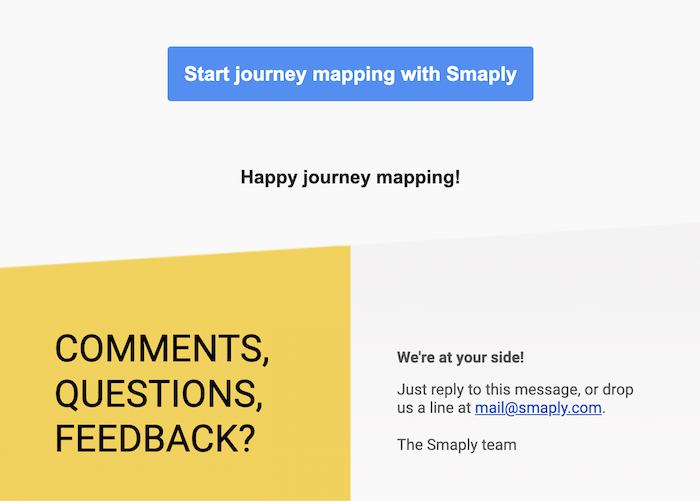
20. Use Video
Ninety-one percent of businesses use video in their marketing, and 87 percent report a positive impact on their sales.
Video email helps promote your brand or product and increases customer engagement and conversions.
There are a few ways you can jazz up your emails with video, like:
- Showing off how a product works and sharing cool customer stories.
- Adding a screenshot of the video with a play button and a link to the full video on your website or YouTube channel.
- Including a snippet of a recent webinar or podcast episode.
- Create a personal email, such as sharing your company’s story or spreading some seasonal vibes.
21. Personalize Your Subject Line
No one wants to feel like they’re just another number on a list. Customers prefer the personal touch.
We’ve all gotten those generic emails that address us as “Dear Valued Customer” or “Hello, Friend.”
Subject lines like these tell us the email isn’t personal, and we’re more likely to ignore them.
According to Klenty, personalization doubles open rates, and it’s easy to do.
Want some tips? Okay. Here are some email marketing best practices for added personalization:
- When crafting your subject lines, consider using personalization tokens for names and locations.
- If you’re in the B2B game, address the subscriber by their company name or role.
- Send emails with a discount for things like birthdays. Everyone loves a birthday bonus!
- Tourism companies and hotels can email the best spots to visit according to the subscriber’s vacation destination.
- Share content that matches customers’ interests or buying behaviors; you’ll find this in your purchase history data.
- If a subscriber shows interest in a product but hasn’t bought it, send them an email with a time-sensitive discount.
You can even combine some of these tactics for an email offer that’s impossible to resist!
Here’s an example from the social media planning platform Planoly, which uses instant personalization in its welcome email.
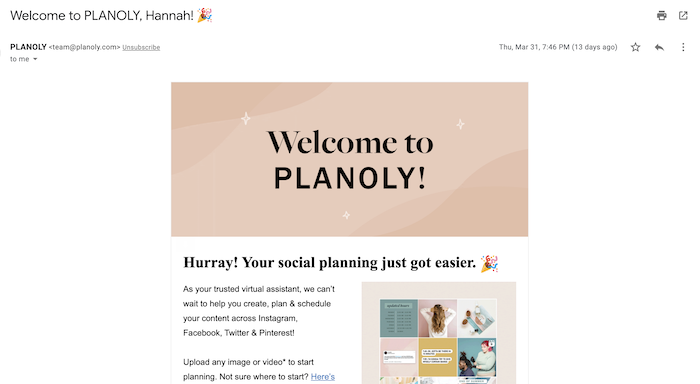
22. Keep It Short and to the Point
Here’s another email marketing best practice: Keep your email subject line concise.
According to ActiveCampaign, subject lines of 4-7 words (41-50 characters) are the sweet spot for email open rates.
Here are a few examples from Campaign Monitor on short and sweet email subject lines.
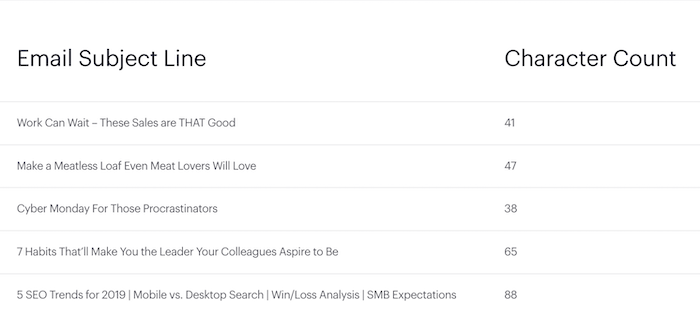
23. Avoid Spam Filters
Studies from MailChimp show certain words, such as “free,” “help,” “percent off,” and “reminder,” can trigger spam filters. But you can avoid this.
For example, you could change “Get your free e-book now!” to “Download your e-book now!”
Or, “10 percent off all shoes” could be “Looking for a new set of sneakers?”
Here is a list of spam trigger words put together by Active Campaign:
There are a few other things you can do to avoid spam filters:
- Don’t use all capital letters in your subject line. This feels like you’re shouting and looks spammy.
- Watch out when using symbols. Some symbols, like $, !, and %, can trigger spam filters.
- Keep your email list squeaky clean. This means only emailing people who actually want to hear from you.
- For large audiences, split them into groups (segment) your lists. This helps your emails get to the right subscribers.
By following these email marketing best practices, you can stay clear of the spam zone and ensure your email lands where you want it to.
24. Ask a Question
Using a question in your email subject line can increase open rates by 10 percent according to research from Yesware, Of course it does!
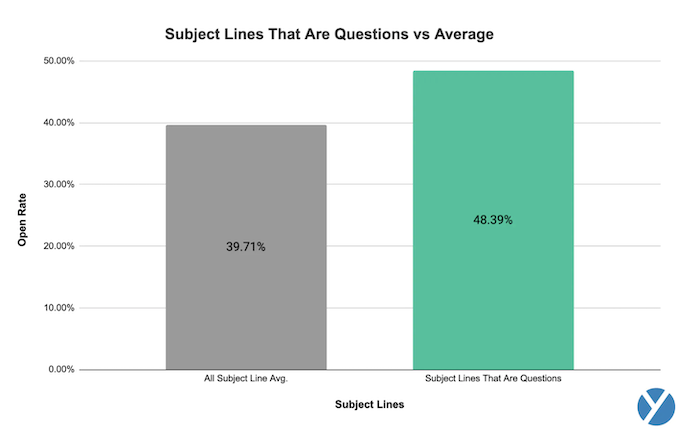
Questions tap into our natural curiosity and make us want to learn more.
For instance, imagine you run an online store that sells hiking gear.
A subject line like “Are you all set for your next hike?” hits your target customer.
And for newbies, go with something like:
“Hey! Need a hand picking the perfect hiking gear?”
By segmenting your email list and asking questions that matter, you can whip up emails that sound like you’re having a personal chat.
25. A/B Test Your Subject Lines
Around 61 percent of email marketers use A/B testing. Given that it can increase click-throughs by 15 percent, I’m kinda surprised this number isn’t higher.
That means almost half of all email marketers campaigns are sending things out there willy-nilly, with no idea whether they’re working.
Don’t be that half!
If you want to get the most out of your email marketing, you need to be A/B testing your subject lines.
Otherwise, how will you know what works best for your audience? You won’t!
You can A/B test email marketing subject lines by:
- audience or segment
- email type
- email content, copy, and design
After you’ve got your results, keep A/B testing regularly.
26. Implement Email List Hygiene
Each year, email list quality can decline by up to 22.5 percent.
Of course, we all know that personal hygiene is essential for good health. And email list hygiene is crucial for keeping your email marketing campaigns in tip-top shape, too.
Email hygiene (validating your subscriber list to remove inactive, bounced, or unengaged email addresses) reduces deliverability issues and bounce rates, and protects sender reputation.
Introducing list hygiene is not just an email campaign best practice. It’s a necessity if you want to avoid your chances of getting flagged as spam.
There’s another reason you’ll want to clean up your email list: It’ll save you money! Sending to inactive subscribers costs resources that you can better use on your most engaged subscribers.
Here are some tips to get your email list sparkling!
- Scrub your list using an email verification service
- Remove inactive subscribers
- Launch a re-engagement campaign
- Keep an eye on bounce rates
- Make unsubscribing easy
27. Encourage Social Sharing
Adding social sharing buttons in your emails is a cool way to get your list to spread the word, and there are many perks that come with it, like:
- Reaching more people beyond your immediate subscriber base.
- Getting your content seen by a bigger crowd (brand visibility.)
- Getting subscribers more involved.
- Boosting brand credibility with user-generated content from likes, comments, and shares.
- Giving you analytics so that you can see how your marketing is doing on social.
Remember to consider the placement of your social sharing buttons to make it a breeze for your subscribers to share. One click should be all it takes.
Also, consider the types of social sharing buttons you offer and choose platforms suitable for your content and audience.
Here’s an example from Ikea:
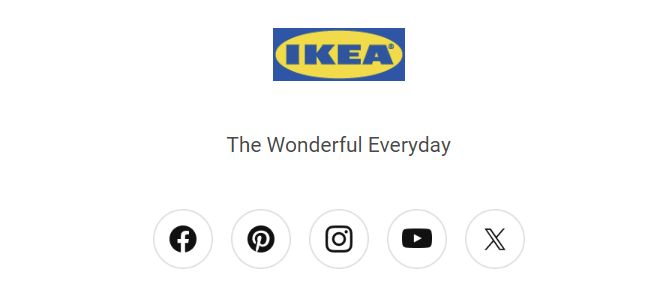
Finally, remember social share buttons are one thing, but you’ll need to create valuable share-worthy content in the first place to get that traction!
28. Monitor and Adapt to Industry Trends
Online marketing doesn’t stand still, so you’ll want to keep up with emerging trends and best practices in email marketing to stay on top of your game.
Here are a few ways you can do just that:
- Try out new tactics and play around with things like subject lines, CTAs, or email design as part of your A/B testing.
- Monitor competitors by signing up for their emails and seeing what they’re doing. It’s an awesome way to keep up with trends and get inspiration.
- Stay in the loop with changes in email marketing regulations and privacy policies, such as GDPR or CCPA.
- Get the scoop from industry newsletters and blogs that give out useful insights, case studies, and expert advice.
- Follow thought leaders and pros in email marketing on their social media channels to stay in the know about the latest trends and best practices.
FAQs
How often should you send emails according to email marketing best practices?
Most companies see the best results when sending emails twice a month. Consider sending emails two to three times a week if you’ve got excellent content, regular discounts, and recurring deals.
How many touchpoints to conversion should there be according to email marketing best practices?
Five to six touchpoints is generally a good place to start. However, some campaigns may only require three touchpoints, while others might need eight or more.
If I follow email marketing best practices, will my conversions increase?
While we aren’t fortune tellers, we base this blog’s content on industry standards that have been proven to work repeatedly. By following these email marketing best practices, you’ll increase your chances of email success.
Do the best practices for email marketing change frequently?
Just like you, your audience is always changing and evolving. As a result, email marketing best practices also change and evolve. However, the basics remain the same. These include segmenting your list, personalizing your email content, and providing value to your subscribers.
Conclusion
Email marketing is a 7.5 billion dollar industry. That number will likely reach 17.9 billion by 2027.
These and other email marketing statistics show this kind of growth is rarely seen in our industry.
By implementing email marketing best practices from the start, you’ll be ahead of the game.
Don’t forget: email marketing is a powerful tool, but it’s not a magic bullet. You still need to put in the hard work to see results.
But if you do, email marketing can take your business to the next level.
What are you waiting for? Implement these email marketing best practices today and watch your business grow!
If you need help getting started, contact our team today.
Continue reading...
